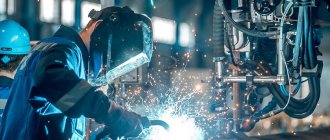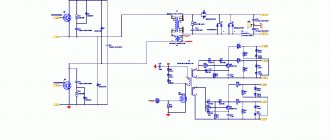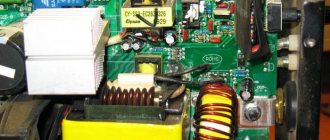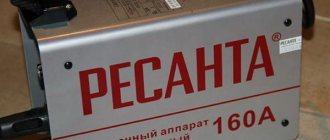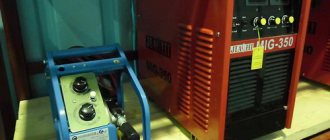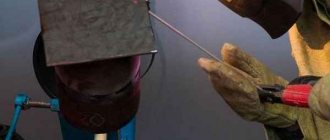Design and functionality
The Resanta SAI 190 welding machine is enclosed in a rectangular body, the dimensions of which are 350x140x250 mm. It is made of durable high-quality steel, and the surface is protected by a layer of paint. Thanks to its large flat base, it is stable on any surface, including slopes. There are slots on both sides of the body that serve for unhindered air penetration. The casing meets IP21 protection class requirements.
A switch and an input for the power cable are installed on the back cover, and a control panel is assembled on the front. It is characterized by the simplicity of the device and even a beginner can understand the functionality. There is a rotary current regulator, a network indicator and an overheat indicator. There are also terminals for connecting welding cables. At the top there are fasteners for a shoulder strap.
Components and elements are located inside the housing. The main element is a transformer that converts the input current with a frequency of 50 Hz into direct current. After this, the current is again converted to alternating current, but its frequency is much higher and amounts to 20 kHz. Thanks to this chain of transformations, it is possible to increase the current strength to 190 Amperes. The voltage in this case is 85 V. The transformer itself has cooling fins on the surface made of light alloy. For better air circulation, two fans are provided.
Reliability of operation and complete safety of operation is ensured by a built-in protection and warning system. Temperature sensors are installed that monitor the temperature increase and warn the user if a dangerous threshold is approaching.
The principle of operation of the welding machine is to ignite a high-temperature arc between the metal surface and the electrode. In this environment, a high temperature is reached, which causes the metal to melt. The melt of the joined edges is mixed, forming a durable monolithic surface. “On-board” functions of anti-sticking and hot start are provided by automatically adjusting the strength of the operating current.
To quickly activate the arc, a powerful electrical impulse is applied when the electrode approaches the metal surface. After the arc ignites, the current decreases sharply, eliminating sticking of the electrode. The electrode coating burns and forms a closed environment, preventing the melt from coming into contact with atmospheric oxygen and nitrogen. This improves the quality of the welded joint.
Welding equipment from Resanta company
The Resanta company was created by Latvian engineers in 1993 to produce voltage stabilizers. Later, production was expanded and production of welding equipment began. The choice was made in favor of inverter models.
Currently, thanks to reliability, convenience and beautiful design, Resanta inverters have conquered the markets of many countries. It’s no wonder that they are made in China and are tested before shipping.
Resanta welding machines
The welding inverter Resanta SAI 190 in various designs is most often used in everyday life. This choice is explained very simply:
- Typically, welders use electrodes with a thickness of 3 mm. To ignite them, it is enough to set 140 A, but a current reserve is required, since you cannot cook at the maximum load; when cutting metal, the load increases, and power is lost when using an extension cord.
Resanta with a maximum current of 190 A has the necessary reserve.
In addition, a welding machine with a higher current value has a higher cost.
- Thanks to special modes, it is easy to master all the subtleties of welding work. These include: accelerated ignition when touching the seam and easy removal of a stuck electrode.
Characteristics of the welding inverter Resanta SAI 190
To operate the manual arc welding machine SAI 190, it is recommended to purchase electrodes with a diameter of up to 5 mm. The maximum welding current is 190 amperes (technical data). However, practitioners note the fact that the figures are overestimated. It is almost impossible to achieve such values in practice, and they are somewhat lower.
The inverter is small in size and light in weight – no more than 5 kg. This is convenient if you have to frequently transport equipment. For example, take it with you to the dacha and pick it up when you return home. Wide operating temperature range: from -10 to +40 degrees Celsius, which is very practical for our climate zone.
It is worth noting the very modest configuration of the welding inverter. The price includes welding and power supply cables. All other equipment will have to be purchased. On the other hand, the equipment comes with a two-year warranty, which gives you confidence in its reliability.
Resanta brand SAI 190 K
Video review of the welding machine:
The next in the line is the Resanta SAI 190 K inverter, which has the following characteristics:
- Highly compact.
- Supply voltage 220 V/50 Hz.
- The highest electricity consumption is 5 kW.
- Thanks to special modes, the electrode quickly ignites and is protected from sticking.
- In case of overheating, rapid recovery is provided (PV - 70%).
- Use of IGBT transistors in an electronic circuit.
Positive user reviews about the welding inverter Resanta SAI 190 K:
- High-quality protection against overheating. For cooling, forced ventilation of the unit is used. The indicator promptly notifies you of overheating.
- To carry out welding, basic knowledge and a little practice are enough.
- Convenient carrying strap.
Negative user reviews:
- The board is not filled with compound. If metal dust gets on it, it burns.
- Insufficient length of welding cables.
- Due to the electronic filling, strict storage conditions. It is not recommended to store in a cold room in winter.
- Welding cables are made of aluminum, so they heat up at high currents.
- There is no screen to control the current value. It is difficult to make correct adjustments in the dark.
Advantages and disadvantages
The Resanta SAI 190 welding machine is endowed with many advantages, one of which is noticeable from the first steps: ease of connection. Simply insert the plug into a household power socket to get started. It is important that the voltage in the network does not vary greatly, and its minimum value does not fall below 200 volts.
The second undoubted advantage is the fact that the “filling” is made on the basis of IGBT transistors. It is thanks to this that the device turned out to be compact, lightweight and with impressive additional functionality.
Now let's take a closer look at its main features. The device is reliably protected from overheating. It has a built-in “anti stick” function, better known among users as “anti-sticking”. No less popular is another feature of “hot start” - quick start, which allows you to ignite the welding arc almost instantly. The presence of these two functions greatly simplifies welding work.
In order to start working with an inverter, it is not necessary to study the theoretical part of electrical engineering. All controls and control buttons are located on the front panel, intuitively understandable and labeled. The large font of the signatures is visible even from a great distance, making it convenient at first to get acquainted with the control panel.
Full list of advantages:
- The model operates from a household power supply and is easy to connect.
- The inverter system involves the use of small transformers. In combination with IGBT transistors, this ensures low weight and modest dimensions of the device.
- There is a built-in overheat warning indication. This makes work more comfortable and safe.
- Anti-stick and hot start functions simplify the use of the unit.
- The switching duration is 70%.
- The durable case reliably protects the interior from damage.
- Wide range of power regulation and the ability to convert high-frequency current.
- The use of alternating and direct current electrodes is allowed.
- No prior specialist training is required. A little practice and basic knowledge about welding is enough.
Now about the disadvantages. The Resanta trademark is registered in Latvia, but production is located in China. This fact is due to two features. First, production located in China makes it possible to create an affordable price for consumers. Secondly, not every buyer can trust the quality of manufacturers from the Middle Kingdom. Everyone will have to make a decision after weighing these factors.
The second important disadvantage lies in the technical characteristics. For the same price, many other Chinese manufacturers offer equipment with much more impressive parameters. Here, buyers have to pay extra for the brand and service. Over time, the functionality of the equipment ceases to be sufficient and to perform more complex tasks you will have to buy another inverter.
What is included?
Upon delivery, you receive the Resanta SAI 190 PN inverter itself, a 2-meter cable with an electrical holder, a product passport, a 1.5-meter cable and a grounding terminal.
Peculiarities:
- large depth of the weld pool;
- possibility of gradual change of current indicators;
- power transistors, which are produced taking into account modern technologies, have made it possible to lighten the weight of the device;
- during operation, metal does not splash in large quantities;
- works well during network fluctuations.
Technical characteristics of Resanta 190 PN:
- Arc voltage - 27 V;
- Weight - 4.7 kg;
- Size - 15 x 30 x 37 cm;
- The value for the maximum current in operation is 25 A;
- Network voltage - 220 V;
- Housing protection - lP21;
- Cooling - air;
- Electrode diameter - 5 mm;
- Idling - 80 V;
- Consumption - 5 kW.
Preparation for work and safety measures
Structurally, the Resanta 190 inverter welding machine is not a complex device. Almost anyone can prepare it for use. It is important to initially provide basic security measures and take some points into account. This is necessary to prevent the possibility of electric shock, as well as to eliminate a number of other unpleasant situations.
The equipment is grounded through the power cord. Therefore, it is necessary to use sockets of the appropriate configuration connected to the ground circuit. The power cord is connected to the power supply after the power welding cables have been connected. The “network” toggle switch is turned on, and the current regulator is moved to the lowest position. After completing the work, the device turns off in the reverse order.
Carrying out welding work indoors requires additional training. It is necessary to take care of ventilation of the internal space. It is imperative to get rid of flammable materials and liquids. You can start work only in personal protective equipment: mask, gloves, headgear, suit made of fire-resistant material, durable closed shoes.
How to use the Resanta 190 welding machine
Before you start working, you should carefully read the safety requirements. Work order:
- The surface of the parts to be welded is cleaned. At a distance of 1-2 cm from the welding seam, the material must be cleaned of paint, oil, dust and other contaminants;
- Hold the welding helmet in front of your face and light the arc. The most effective method is considered to be “striking” - on the principle of lighting an ordinary match;
- After activating the welding arc, you need to hold it. To do this, it is necessary to maintain a distance from the electrode to the metal surface, which is equal to the consumable. It is advisable to maintain the vertical tilt angle in the range of 20-30 degrees;
- upon completion of the formation of the welding seam, the electrode should be pulled back a little, and then sharply returned to its original position so that the bath is filled with melt;
- the slag is cleaned using a special welding hammer or a stiff metal brush;
- It is safer to replace the electrode and move the elements being welded using dielectric pliers;
- When changing the electrode, you need to turn off the welding machine, first reducing the current to the minimum value.
For safety reasons, it is prohibited:
- operate the equipment indoors with high humidity or in an open area during rain;
- use abrasive and cutting metalworking tools in close proximity to the inverter. This will lead to small metal particles getting inside, which will ultimately lead to equipment failure;
- work if the insulation on the supply or welding cable is damaged;
- turn on the device brought from the cold to a warm room. It is necessary to allow the equipment to gradually warm up (adapt) to avoid the formation of condensation.
Circuits and faults
Below are several diagrams that will help specialists understand the principles of the design and operation of the equipment.
Sometimes malfunctions occur that the user can fix on his own. These are, as a rule, minor defects that do not require special knowledge or skills to correct. Serious breakdowns force owners to contact service centers or specialized repair shops. So, now in more detail:
- Equipment overheating or power supply failure . In this case, you need to seek the help of specialists and contact a workshop.
- The network indicator does not light up . First of all, you need to check whether the plug is plugged into the socket and the position of the toggle switch on the control panel. If everything is in order here, then you need to connect an electrician to the solution.
- The equipment is not operating at full capacity . The reason for this may be a wet electrode surface or too low voltage in the power supply network.
- The overheat indicator lights up . You need to remove the housing and check for clogging of the cooling system and clean it if necessary. If manipulations do not help improve the situation, you should contact the workshop.
- Fan switches off when there is no overheat signal . Contact the service center.
- The indicators flash for a long time when turned on for the first time . Working in argon welding mode is characterized by arc instability. The device needs to be repaired by specialists.
- The inverter stops working and makes a loud clicking noise . The cause may be a burnt contact or wiring. Adjustable pads and relays need to be checked.
- When turned on, it breaks ground . Indicates a violation of the wiring insulation. You need to check it carefully.
- Two diodes blink on the front panel, and the fan turns on and off synchronously with them . This behavior of equipment components indicates a malfunction of the cooling system. Most likely the control chip has failed. In cases where the cooler power supply is interrupted by the relay, it should be replaced with a new one.
- The lights flash, the relay activates, and the fan turns on . After one second, everything turns off and the process repeats again. It is necessary to check the resistance R43 (indicated in the diagram - 51 Ohm, 12 V), diode D14 and output transistors.
- The current adjustment knob turns too easily . Over time, the fastening weakens and becomes loose. The worn part needs to be checked and replaced.
- The fan has collapsed . The material from which it is made is very fragile. The entry of a foreign object or branch inevitably leads to destruction. The part needs to be replaced.
- The braid on the wire cracks when working in the cold . Not all wiring is designed to operate in sub-zero temperatures. You need to stop working or purchase the appropriate cable.
